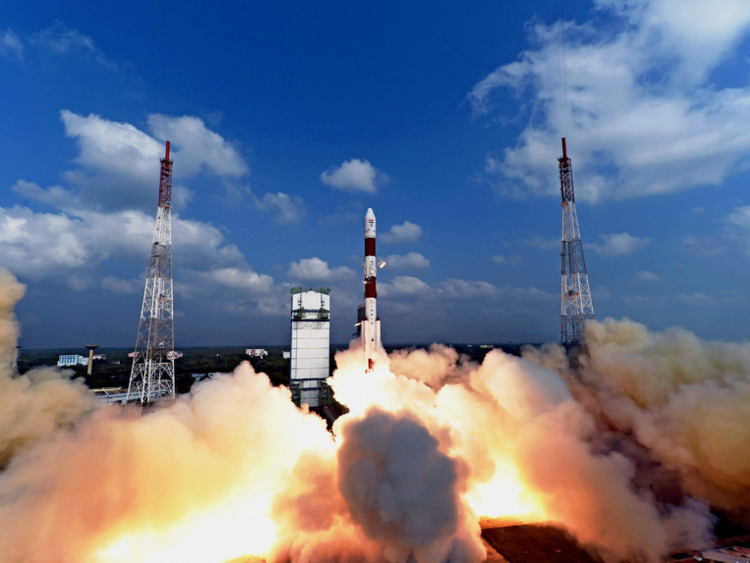Indians are obsessed with record keeping. The Guinness World Records issues certificates for quirky achievements like having the longest moustache, owning the longest ear hair, and for the most persistent letter writer.
But recently when India sent 104 satellites into space in a single launch, it was a feat that went far beyond this infatuation for records.
With this spectacular space shot, Isro (Indian Space Research Organisation) — the nodal governmental agency for the country’s space programme — showcased its growing technological skills and its ability to compete in the $300 billion (Dh1.1 trillion) global space market.
Earlier missions — the lunar probe-Chandrayaan 1 and the Mar’s orbiter, Mangalyaan — signalled India’s coming of age in space.
Despite this success, the frontiers of space are not yet within Isro’s grasp. It has always been disadvantaged by the lack of a powerful indigenous rocket to put heavier satellites into space. Most of the 104 satellites that were sent into orbits were nano satellites weighing no more than a few kilograms.
The good news for India is that it is well on its way to mastering the technology to build bigger rocket launchers. This opens up a vast array of opportunities for commercial as well as strategic reasons. A moon landing, manned space flights, deeper probes to Mars, the thrusting of heavier communication satellites into space and the construction of an Indian space station are all dependent on this capability.
For Isro, the Polar Satellite Launch Vehicle (PSLV) is its workhorse. During the 25 years it has been in use, its track record has been stellar, with 39 successful launches and counting. Its limitation is its lower lift-off mass — only payloads of up to 2.4 tons with the augmented PSLV XL — can be thrust into space.
These satellites are versatile and serve a variety of functions, but until India develops an indigenous Geosynchronous Satellite Launch Vehicle (GSLV) that can handle heavier payloads — 4 tons and above — it cannot aggressively compete in the $300 billion space market as well as meet its strategic goals.
India has been dependent on French Ariane rockets or the Russian GSLVs modified by India to place heavier satellites in orbit. The key element in the GSLV is the cryogenic engine and Isro has been struggling for a while to get its hands around this engine.
The country is finally on the verge of achieving this breakthrough. A series of successful cold and hot tests, some as recent as February 2017 have been conducted and a full scale launch in December this year will see the country finally breaking its shackles from outside sources. India’s long journey in mastering cryogenic technology has been arduous and time consuming.
The first cryogenic study team was put together in 1982, then in 1991 a deal was signed with the Soviet company Glavkosmos to buy cryogenic engines as well as the technology to make them in India. This agreement, however, was cancelled because it ran afoul of the Missile Technology Control Regime — the MTCR was drawn up specifically to prevent the spread of missile-related technology. So later this year when India’s GSLV Mark 3 with its own cryogenic engine, CE-25, blasts off, it will have thumbed its nose at the world. Indeed India’s odyssey in mastering cryogenics is well captured by Irish space writer Brian Harvey in his book Russian in Space — the failed frontier.
Undoubtedly, Isro is a success story but the question is, why is it an exception? Mint’s Why Isro has a legacy of success examines this. It compares Isro with another governmental body, the Defence Research and Development Organisation (DRDO) that is charged with defence-related research and development.
Both share some similarities, both are technology- and research-centric. Developing an integrated missile system for India is one of DRDO’s core responsibilities and this covers ballistic missiles with a range of 150km to 5,000km. DRDO’s remit goes beyond missiles — the development of tanks, radar, avionics, light combat aircraft and special missiles for the navy are some of the other areas of its responsibility.
DRDO has its share of glory but its record is patchy and the Mint finds a variety of reasons for this glaring contrast. Excessive bureaucratic oversight, organisational structural weakness, poor accountability and inherent handicaps that DRDO faces because it works in a domain that is shrouded in secrecy wherein technology transfers are inconceivable.
In comparison, Isro, despite facing hurdles, has enjoyed a greater level of international cooperation. So it would appear that the very comparison itself is skewed. DRDO confronts a far more challenging environment. The public perception is also hugely in favour of Isro as its rocket launches are media spectaculars unlike the muted celebrations for DRDO’s missile blast-offs.
Unquestionably Isro deserves every bit of its high reputation. Its path-breaking work and consistent ability to launch satellites at a fraction of competitors’ costs is astonishing. Isro has scripted space history and will remain — in a bittersweet fashion — an exception. It represents the finest in the Indian scientific tradition.
- Ravi Menon is a Dubai-based writer, working on a series of essays on India and on a public service initiative called India Talks.









